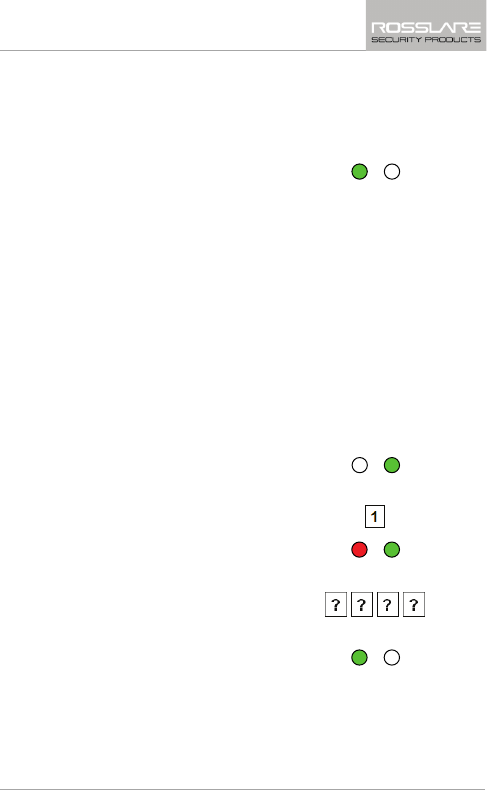User's Manual
Table Of Contents
- 1. General Information
- 2. Technical Specifications
- 3. Installation
- 4. Wiring Instructions
- 5. Reader Functionality
- 5.1 Transmit Mode
- 5.2 Programming the AYC-Ex5 and AYC-T65
- 5.2.1 Entering Programming Mode
- 5.2.2 Exiting Programming Mode
- 5.2.3 Selecting Keypad Transmission Format
- 5.2.3.1 Keypad Transmission Format Option Number
- 5.2.3.2 Option 1: Single Key, 6-Bit Wiegand (Rosslare Format)
- 5.2.3.3 Option 2: Single Key, 6-Bit Wiegand Nibble and Parities
- 5.2.3.4 Option 3: Single Key, 8-Bit Wiegand Nibbles Complemented
- 5.2.3.5 Option 4: 4 Keys Binary + Facility Code, Wiegand 26-Bit
- 5.2.3.6 Option 5: 1 to 5 Keys + Facility Code, Wiegand 26-Bit
- 5.2.3.7 Option 6: 6 Keys BCD and Parity Bits, Wiegand 26-Bit
- 5.2.3.8 Option 7: Single Key, 3x4 Matrix Keypad (MD-P64)
- 5.2.3.9 Option 8: 1 to 8 Keys BCD, Clock & Data
- 5.2.4 Selecting Proximity Card Transmission Format
- 5.2.5 Changing the Programming Code
- 5.2.6 Changing the Facility Code
- 5.3 Setting the Backlight
- 6. Controller Functionality
- 6.1 Normal, Secure, and Master Users
- 6.2 Modes of Operation
- 6.3 Auxiliary Input & Output
- 6.4 Door Alarms
- 6.5 Internal Case and Back Tamper
- 6.6 Lockout Feature (Keypad Tamper)
- 6.7 Request to Exit (REX) Function
- 6.8 Secure Application Appurtenances
- 6.9 Programming the AYC-Ex5 and AYC-T65
- 6.9.1 Entering Programming Mode
- 6.9.2 Exiting Programming Mode
- 6.9.3 Changing Lock Strike Code
- 6.9.4 Changing Auxiliary Code
- 6.9.5 Changing the Programming Code
- 6.9.6 Changing the Normal/Secure Code
- 6.9.7 Changing the Normal/Bypass Code and Door Chime Settings
- 6.9.8 Setting Fail Safe/Secure Operation, Tamper Siren and Lock Strike Release Time
- 6.9.9 Defining the Auxiliary Input and Output
- 6.9.10 Detailed Reference Guide
- 6.9.11 Setting the Lockout Feature
- 6.9.12 Setting the Backlight Behavior
- 6.9.13 Enrolling Primary and Secondary Codes
- 6.9.14 Deleting Primary and Secondary Codes
- 6.9.15 Relay Codes Assignment
- 6.9.16 Relay Code Assignment using Standard Method
- 6.9.17 Relay Code Assignment using Search Method
- 6.9.18 PIN Code Length/Factory Default Settings
- 6.9.19 Replacing a Lost Programming Code
- 6.9.20 Exiting Secure Mode if Normal/Secure Code was Lost
- A. Declaration of Conformity
- B. Limited Warranty

Controller Functionality
AYC-Ex5 and AYC-T65 Installation and Programming Manual 41
6.9.2 Exiting Programming Mode
1. Press the # key twice within 2 seconds.
You hear 3 beeps.
The Door LED turns off and the
Mode LED returns to Normal
mode.
Wrong entries reset the controller back to Normal mode.
While in Programming mode, if no key is pressed for one minute,
the unit exits Programming mode and returns to Normal mode.
6.9.3 Changing Lock Strike Code
The Lock Strike code is mainly used as a method to quickly test the
Lock Strike Relay during installation.
When the first user is added to the controller, the default Lock Strike
code is automatically deleted. Once the code is programmed again, it
is not deleted with the entry of additional user codes.
1. Enter Programming mode.
2. Press “1” to enter Menu 1.
The Mode LED turns red.
3. Enter the new code you wish to
set as Lock Strike Code 1.
The system returns to Normal
mode.
You hear three beeps.
Mode/Transmit
Door/Program
Green
Mode/Transmit
Door/Program
Green
Mode/Transmit
Door/Program
Red
Green
Mode/Transmit
Door/Program
Green










